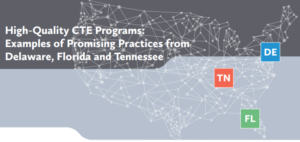A recent article from the Community College Research Center (CCRC) highlights efforts from CCRC and the American Association of Community Colleges (AACC) to implement guided pathways reforms at community colleges. The goal of guided pathways reforms is to create college environments that learners can easily and confidently navigate to completion and successful employment upon completion, and includes four main practice areas:
- Mapping pathways to student end goals;
- Helping students choose and enter a program pathway;
- Keeping students on a path; and
- Ensuring that students are learning.
Reforms in all four of these areas require major changes to program structure, advising, administrative policies and classroom practice, and therefore require buy-in across the institution and a several-year commitment to the reform process. CCRC and AACC have been working with 30 colleges to implement guided pathways through the Pathways Project, and shared some of their lessons learned from the project’s first year.
For example, Jackson College in Michigan quickly realized that its four advisors for more than 5,000 students were not adequate for helping all students learn about and choose program pathways. The college has now hired “student success navigators,” who call every single student before orientation and work with each student in person multiple times in their first semester to design a pathway that works for them. San Jacinto College in Texas reorganized its 144 degree and certificate programs into eight meta majors, allowing a student to choose one of the eight early on and begin introductory courses without being locked into a specific degree or certificate program. The college also worked on transfer-oriented programs by creating maps for the college’s five most common transfer destinations to help students choose the courses that will allow them to transfer non-elective college credit to the new institutions.
For Effective CTE, States Should Adopt Eight Non-Negotiables
ExcelinEd recently released a new playbook for state policymakers related to effective CTE. The report argues that while the importance of CTE has been recognized at the federal, state and local levels, not enough has been done to ensure that CTE programs are meeting workforce needs effectively. This is largely attributed to common challenges of the broad spectrum of programs available, the disconnect between K-12 and industry, and the negative legacy of “vocational education.” To address these challenges, the report recommends that states adopt eight “non-negotiables” related to their CTE policies:
- All promoted programs of study align with state and/or regional industry and labor market data;
- Programs of study incorporate experiential learning and capstone experiences valued by industry;
- Secondary programs of study vertically align with postsecondary programs;
- Courses are sequential and progressive in a given program of study;
- Secondary programs of study incorporate courses and exams eligible for postsecondary credit or hours where appropriate;
- Course standards are robust and accurately represent the academic, technical and employability skills learners must master;
- Educators receive ongoing, progressive training and professional development to ensure their instruction is reflective of course standards and current industry work environments; and

- Federal, state and local funding are utilized to leverage and drive programmatic changes leading to the implementation of vertically aligned education-to-career learning pathways.
The authors propose that these eight non-negotiables be implemented in a four-phase plan, to ensure thoughtful and sustainable changes are occurring. They provide examples of successful implementation of each of the eight non-negotiables in Delaware, Florida and Tennessee.
Odds and Ends
The Georgetown University Center on Education and the Workforce recently released a new report on the integration of education and workforce data. The report focuses on states who have created publicly available data tools in five areas:
- Education Projections, Business Expansion, and Workforce Quality
- Program Alignment with Labor Market Demand
- Curriculum Alignment with Workforce Requirements
- Counseling and Career Pathways
- Job Placement and Skills Gap Analysis
Education Commission of the States recently released a 50-state comparison of policies related to Prior Learning Assessments (PLAs). PLAs allow learners and institutions to determine the level of previous of knowledge and experience before entering a postsecondary program, and can be used to incentivize re-entry for older learners.
A new report from the American Enterprise Institute examines the barriers community colleges face in providing high-quality CTE, including funding allocations, accreditation requirements and credit-transfer policies, among others. The report also makes recommendations for community colleges to make the most of their CTE offerings and reduce the proliferation of general studies programs at community colleges.
Ashleigh McFadden, State Policy Manager
Tags: community college, Delaware, Florida, guided pathways, prior learning assessments, tennessee, workforce data

